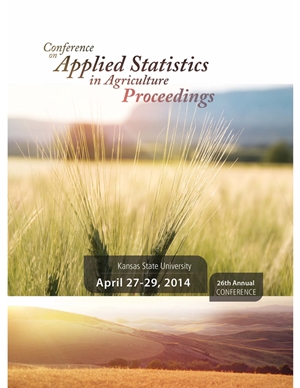Abstract
The insect order Coleoptera, commonly known as beetles, comprises 40% of all insects which in turn account for half of all identified animal species alive today. Coleopterans frequently have large elytra (the hardened front wings) that can have a wide range of colors. Spectral reflectance readings from these elytra may be used to uniquely identify coleopteran taxonomic groups. Multiple samples of eleven species of wood boring beetles were selected from the University of Idaho William Barr Entomology Museum. Spectrometer readings for each specimen were then fit to normal distribution mixture models to identify multiple peak reflectance wavelengths. Eighteen prominent peaks were identified across all taxonomic groups and genders creating a multivariate response structure. Multivariate statistical procedures including principal component and discriminant analyses were employed to assess the differentiation of taxonomic groups and genders based on spectral reflectance. The first three axes of the principal component analysis accounted for 96% of the variation and provided a clear clustering of genus and gender for a subset of taxonomic groups. The linear discriminant analysis under an assumption of multivariate normality provided a distinct classification of taxonomic groups resulting in an overall 4% misclassification rate; while the nearest neighbor discriminant analysis with a proportional prior gave an overall error rate of 5.2%. Internal bootstrap validation of the latter discriminant model yielded an average error rate of 3.5%. An external cross validation of the same model, conducted on independent samples of the same species with new individuals resulted in an average misclassification error rate of only 6.5%. Given the low error rates of misclassification, such multivariate statistical approaches are recommended for analysis of spectral reflectance in Coleoptera and other similar insect groups.
Creative Commons License

This work is licensed under a Creative Commons Attribution-Noncommercial-No Derivative Works 4.0 License.
Recommended Citation
Herberger, Sarah E.M.; Shafii, Bahaman; Cook, Stephen P.; Williams, Christopher J.; and Price, William J.
(2014).
"MULTIVARIATE STATISTICAL ANALYSIS OF COLEOPTERA SPECTRAL REFLECTANCE,"
Conference on Applied Statistics in Agriculture.
https://doi.org/10.4148/2475-7772.1002
MULTIVARIATE STATISTICAL ANALYSIS OF COLEOPTERA SPECTRAL REFLECTANCE
The insect order Coleoptera, commonly known as beetles, comprises 40% of all insects which in turn account for half of all identified animal species alive today. Coleopterans frequently have large elytra (the hardened front wings) that can have a wide range of colors. Spectral reflectance readings from these elytra may be used to uniquely identify coleopteran taxonomic groups. Multiple samples of eleven species of wood boring beetles were selected from the University of Idaho William Barr Entomology Museum. Spectrometer readings for each specimen were then fit to normal distribution mixture models to identify multiple peak reflectance wavelengths. Eighteen prominent peaks were identified across all taxonomic groups and genders creating a multivariate response structure. Multivariate statistical procedures including principal component and discriminant analyses were employed to assess the differentiation of taxonomic groups and genders based on spectral reflectance. The first three axes of the principal component analysis accounted for 96% of the variation and provided a clear clustering of genus and gender for a subset of taxonomic groups. The linear discriminant analysis under an assumption of multivariate normality provided a distinct classification of taxonomic groups resulting in an overall 4% misclassification rate; while the nearest neighbor discriminant analysis with a proportional prior gave an overall error rate of 5.2%. Internal bootstrap validation of the latter discriminant model yielded an average error rate of 3.5%. An external cross validation of the same model, conducted on independent samples of the same species with new individuals resulted in an average misclassification error rate of only 6.5%. Given the low error rates of misclassification, such multivariate statistical approaches are recommended for analysis of spectral reflectance in Coleoptera and other similar insect groups.


